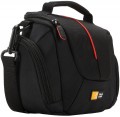—
For cameras (DSLR). Bags or other protective devices designed for DSLR cameras. Such cameras are much larger in size than most compacts; in addition, when using them, you have to deal with many detachable accessories - lenses, flashes, boosters, etc. Taking this into account, products for this purpose should have good capacity, and ideally - also compartments or external pockets for additional equipment. On the other hand, there is no official division into bags for DSLRs and compacts, so in this case it is rather arbitrary. In our catalog, two types of products are considered models for DSLR cameras: firstly, those in which the size of at least one dimension is 150 mm or more; secondly, those in which special equipment is provided, such as a separate pocket for a lens (regardless of the dimensions of the bag).
—
For cameras (compacts). Bags designed for use with compact cameras. In addition to their small size, such cameras are also characterized by autonomy — in the sense that everything necessary for shooting is usually built into the device itself: non-removable optics, its own flash, etc. Therefore, bags for compact equipment do not need large dimensions and additional pockets/compartments. Therefore, in our catalog, all products whose dimensions do not exceed 150 mm, and the design does not provide for special "SLR" equipment, are classified as models for compacts (for more information on suc
...h equipment, see above).
— For video cameras. A bag for a video camera, designed to protect against mechanical damage and accidental impacts. Can be additionally protected by a frame made of plastic or metal, which gives additional rigidity. Various materials are used for manufacturing. Equipped with additional internal or external pockets.
— For lenses. The bag is designed to protect interchangeable lenses of photo and video devices.
— Tripod case. Cases are available in different sizes (lengths) for tripods with different heads. The case usually opens with a zipper along the entire length, which allows you to quickly put in or take out the tripod. Often, waterproof materials are used for manufacturing.When choosing a camera bag, pay attention to the size of the camera compartment. This compartment is designed for storage and safe transportation of photographic equipment, and has dense and soft protective walls. The larger the size of the camera and the number of lenses / photo accessories used, the larger and more spacious the compartment for storing them should be.

